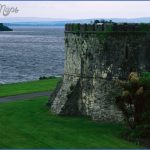The Republic of Ireland has long been a good buy for tourists, offering accommodations from bed and breadfast to luxury castles and mansions. The country is an independent nation, not a part of the United Kingdom as is Northern Ireland. Not all the B & B’s are attractive, but some are served up in attractive farmhouses and Georgian homes left over from the days when the English built mansions with cheap Irish labor. Ashford Castle in Cong and Cashel Palace Hotel in Cashel, Dromoland Castle near Shannon and Killiney Castle Hotel in Killiney are bona fide castles or palaces converted into hotels.
The Irish decided to coerce visitors into helping the economic development around Shannon, on the west coast. Only passengers flying Aer Lingus, the Irish national airline, can fly directly to Dublin from the United States. Buses take thirty-five minutes to get into the center of Dublin. Other airlines must put down at Shannon, 138 miles southwest. Passengers change to a local Aer Lingus flight into Dublin or bus to Limerick and into Dublin by train, a two-hour ride. Many visitors stop overnight, shop and enjoy the castle entertainment and meals nearby.
must for most tourists to County Cork, Ireland, is the ritual of kissing the blarney stone at Blarney Castle. The stone is said to make those who kiss it skilled in flattery.
Source: Irish Tourist Board.
Shannon offers a free port, authentic thatched-roof cottages for rent and dinner at a choice of three medieval castles Dun Guaire, Bunratty, or Knappogue. Costumed waitresses serve what is supposed to resemble medieval fare downed with mead, the alcoholic beverage made from honey.
Getting around Ireland is easy by rented car. There is very little traffic on the roads outside the few cities and towns. The Eurail Pass is also good in Ireland.
Dublin, a city of a million sitting on the Liffey River, is known for its Trinity College, its pubs and its Irishness. The Trinity College Library has the Book of Kells, judged by many to be the most beautiful blog ever produced. The library itself is grand in the manner of the royal library in Vienna. Visitors are taken with the homey quality of the pubs and the easy conviviality. Only the natives can wax eloquent over Guiness stout, which is almost a national drink. The Gresham and Shelbourne hotels are hostelries that have acquired reputations over many years. Don’t try to remember Dublin’s official name, Baile Atha Cliath.
Called the Emerald Isle for a reason, Ireland is kept moist (too moist many say) by southwesterly winds blowing off the North Atlantic Drift (that originated as the Gulf Stream in the Caribbean). Rain is common and can come down in torrents. The Atlantic Drift also keeps the climate mild. The temperature seldom drops below freezing nor rises above seventy-five degrees. Most northwesterly of the Eurasian land mass, Ireland is separated from Great Britain by the Irish Sea. Don’t plan to swim off Irish coasts. The water is too cold. Although most of the central parts of the island are an undulating plain, most of the island is rimmed by coastal highlands.
There are two Irelands, Northern Ireland and Ireland. Ireland is the southern portion, referred to as the Irish Republic. It occupies five-sixths of the island and has two-thirds of the population, a little over three million people. The northeast corner constituted six counties of Ireland until the early 1920s. Today it is part of the United Kingdom of Great Britain and Northern Ireland. Northern Ireland’s capital is Belfast, population 360,000. Ireland’s capital is Dublin, population 680,000.
Ireland is a land of small towns and villages connected by paved, mostly narrow roads. Drive on the left side, please. And no honking between 11:30 p.m. and 7 a.m. The Irish are known for their love of ale, sports, and song. All three can lead to driving while under the influence and severe penalties if picked up by the police.
The island has a number of lakes called loughs. Most visitors head for the Ring of Kerry, a circular road on the Iveragh Peninsula with spectacular views of mountains and ocean. Close by is Blarney Castle, where visitors line up to kiss the Blarney Stone and thereby, it is said, increase their skills in flattery or blarney. The Connemara on the west coast is rocky and mountainous. Thirty miles offshore are the Aran Islands, almost barren, windy and lonely.
Remember Tipperary, in the song, It’s a long way to Tipperary? It’s in the southwest, surrounded by hills and mountains.
Identification of an Irish cuisine is difficult because the famed Irish imagination has not been applied to cooking. It is substantial fare: bacon, Irish stew, soda bread, cabbage, carrots, and corned beef are well-known. Irish potatoes did not originate in Ireland but saved many an Irishman from famine. When the potato crop failed many died and millions left the country. Luckily, tens of thousands immigrated to the United States. Irish salmon and Dublin Bay prawns (large shrimp) are the grander type of food on the Irish menu. So too are oysters when in season. Spring lamb is delicious. When the Irish are not drinking tea it is beer, stout, ale, and Irish whiskey. The tea comes strong, hot and sweet; the beer comes with a higher-than-normal alcoholic content which apparently lubricates the fiddling and singing in Irish pubs.
IRELAND Photo Gallery
Maybe You Like Them Too
- The Best Cities To Visit in The World
- World’s 10 Best Places To Visit
- Coolest Countries in the World to Visit
- Travel to Santorini, Greece
- Map of Barbados – Holiday in Barbados












